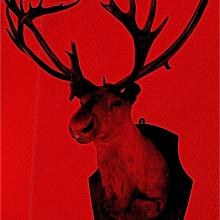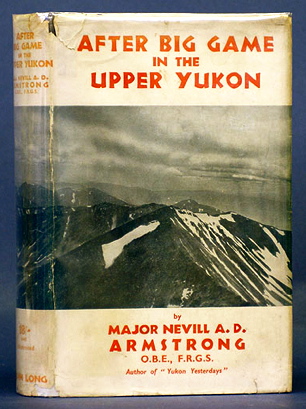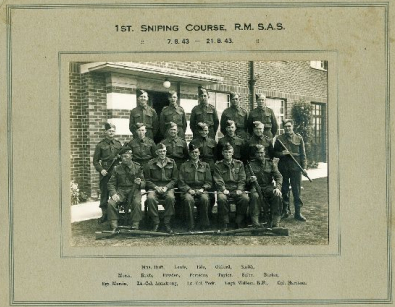
In Issue 189 we looked into the murky past of Broughton's mounted caribou, but Spurtle's researches uncovered far more interesting and peculiar material than we had room for in the printed edition.
Here, then, are miscellaneous links and gleanings which didn't make it into the final article.
First, thoroughly recommended are the unexpectedly deep and occasionally disturbing waters of William O. Proitt Jr's article 'The Function of the Brow-Tine in Caribou Antlers'; full of surprising details on erotic epigamic antler threshing. A pdf can be downloaded from the foot of this page.
Second, if all that science has got you into a lather, perhaps calm down by following some of the 'Try This!' suggestions at www.learner.org.
Nevill Armstrong's ancestry and relations by marriage can be found in: Charles Hosley (ed.) Burke's Peerage, Baronetage and Knightage, 10th edn (2003), Vol. 1, p.139. Or see: http://thepeerage.com.
Between 1894 and 1926, Armstrong kept 22 diaries (whose contents include records of a short stay in New Mexico, and a detailed temperature chart for Russell Creek in the year 1905). These are available in the Yukon Archives at Whitehorse (YA MG 30-E2), should you ever find yourself passing.
The Armstrong Creek, and the surrounding area of Armstrong, are named after him. One of the huts he built and lived in can be seen here, as can two well-covered visitors.
He was entered into the Yukon Prospectors Association Hall of Fame in 1988, being one of 172 inductees who had 'struggled against seemingly impossible odds, suffered undue hardship, and incurred incredible risk in their search for minerals in the Yukon'. You can see the commemorative monument on which his name is inscribed at: http://north-land.com.
Some of Armstrong's splendid recollections of Goldrush days are repeated in Lael Morgan, Good Time Girls of the Alaska–Yukon Goldrush (Epicentre Pess, 1999), pp. 42–3, 47, 105, 299. Read it online at: http://books.google.co.uk. His encounter with Edith Niele 'the Oregon Mare' starts around here.

Armstrong entered the 16th Batallion of the 'Canadian Scottish' from a 'non-permanent active militia'" the 79th Regiment, Cameron Highlanders of Canada, drawn from Winnipeg and Manitoba.
The Allies' development of systematic sniping was initially unpopular even among their own troops, but was an inevitable response to highly effective German sniping which – at its height in the first two years of the war, was accounting for around 100 fatalities a day. By the end of the war, Allied snipers were more than matching their German opponents, thanks largely to their Canadian instructors. In his Fieldcraft, Sniping and Intelligence (1940), Armstrong defined the sniper as:
... an expert rifleman 'out to kill' who is highly trained in observation and the use of ground; equally valuable in trench and open warfare.
He should be able to pick out targets exposed for only short periods and kill with a single shot from concealed positions.
Out of 5,491 men in the 16th Batallion, 1,346 were killed in action during the First World War. Armstrong served on the front line in France between October 1915 and February 1917, being mentioned in despatches on 1.6.17, 28.12.17, 31.12.18 and 11.7.19. He was then seconded to the Canadian Corps School France until January 1919. From November 1919 until May 1920 he was based in the Historical Section, Military HQ, Ottawa. He left the Army, struck off at full strength.

At the start of the Second World War, Armstrong began as an instructor in the Sniping Wing of the Small Arms School Hythe and Bisley. In 1942 he moved on, becoming Commandant at the Royal Marine Sniping School. In an unclear image from this period, he is pictured on the front row, second from the left. This is the only image yet found of him.
On sniping see: Hugh MacIntyre Urquhart, Canadian Expeditionary Force 1914–19 (Toronto, 1932); Leslie P. Mepham, 'Making their Mark: Canadian Snipers and the Great War 1914–1918' (MA thesis, University of Windsor, 1997)
In 1919, Armstrong appealed for divorce. The respondent was his wife, and the co-respondent one John B. Aitken. The case is archived at J77/1534/7512.
Publications by Armstrong available in the National Library of Scotland are:
After Big Game in the Upper Yukon (1937); Fieldcraft and Stealth: the Training of the Soldier in Stalking-Crawling-Patrolling (1942); Fieldcraft, Sniping and Intelligence (1940); Yukon Yesterdays. Thirty Years of Adventure in the Klondike, etc. (1936)
We have barely scratched the surface of this story, and some outstanding areas for research are suggested below. If any reader has the energy, interest and time to pursue them please do so (but kindly let Spurtle know first to avoid unnecessary duplication of effort).
- Does anyone know how to age or sex the mounted caribou from its antlers?
- Can anyone find the text of the despatches in which Armstrong's gallantry was described?
- It is still unclear what the occasion was for the presentation of the caribou head. Perhaps the Royal Scots Museum may have an archive in which this information could be found.
- Does anyone know of photographs for Armstrong, particularly in youth?
- What of Armstrong's later life? Where did he live? With whom?
- Any obituaries in Canada? None found so far in Britain.
AM
What follows is an attempt to harness the power of Google which should not be read as modern prose poetry: Nevill Alexander Drummond Armstrong N.A.D. Armstrong N. Armstrong Nevill Armstrong hunter sniper sniping goldrush Yukon big game prospector Canada author
For an exciting development, a little over 4 years after first publication of this article, see Breaking news (8.2.14).